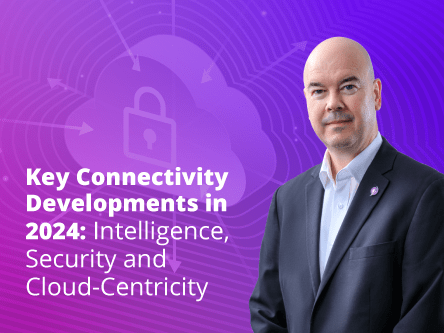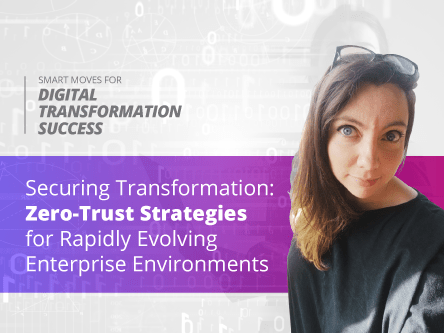Digital transformation in today’s business landscape can never truly happen without successful executive alignment. The whole executive team need to be aligned with the vision behind any proposed digital transformation roadmap, otherwise the chances of long-term measurable success are limited. This can be difficult when team members have differing, or even conflicting, views on the organisation’s path forward on its digital journey.
A recent Leadership IQ study found that only 29% of employees believe their leader’s vision for the future is always aligned with the organisation’s.
Mid-market CTOs are continually faced with the challenge of gaining full Board acceptance or approval for technology investments, which can slow down the entire digital transformation process for enterprises globally. Whether it is investing in new networking models like Network as a Service (NaaS) or migrating more applications to the cloud or embarking on new technologies such as AI, it all requires buy-in from the leadership team to get started and deliver results.
For CTOs, succeeding at executive alignment can be the difference between accelerating organisational change or delivering more of the same. From a technology point of view, it is important to assess existing challenges and potential opportunities to pave a clear path towards successful transformation.
This comprehensive view of the organisation and its processes must be relayed to the entire executive team. They need to not only understand, but also believe in the success that the proposed transformation projects can deliver.
The Risk of Inaction
For some CTOs, aligning the technology, varying views of their leadership team, and the organisation’s core mission and vision, is a task with too many barriers and challenges to undertake. The risk is a fragmented digital transformation roadmap and that an organisation continues to operate with the same legacy technologies and processes, because it is just too difficult to change.
However, these companies that remain ‘stuck in their ways’ are at an even greater risk than those that take the leap to improve operations with up-and-coming technologies. Legacy processes can be slow, fragmented and inefficient, ultimately leading to both monetary and productivity losses. For example, global financial institutions, according to IDC Financial Insights, are projected to spend a staggering $57 billion on outdated payment systems by 2028, with costs rising at a significant rate of 7.8% annually. Whether it is the financial services industry, telecommunications, manufacturing or retail, no sector is exempt from the losses that can occur due to legacy technologies.
It might feel easier to avoid the challenges of executive alignment and operate your business the same way as you always have done, but this puts you at a higher risk of getting left behind your competitors. The time to transform is now.
Aligning Your Executives
Succeeding at executive alignment means being a business and technology expert with the ability to translate between the two.
The best way of doing this from a personal development perspective is to spend time working in, or at least developing a good understanding of, the different parts of the business. This will enable you to gain an awareness of how things work and how they tick along together (or how they don’t).
There are five key stages to think about when planning a successful digital transformation strategy:
1. Create a Foundation for Transformation
When developing your roadmap for digital transformation, a clear vision and strategy are vital. This transformation will affect everyone across the company, across various levels and departments. In order to create a solid vision and strategy, you must consider the company as a whole and get the executive team on the same page.
Collaboration is critical at this stage to create a foundation for success. You must get key process owners together for an in-person or virtual meeting to discuss ideas, or host these meetings in subgroups for larger companies, to ensure the entire team feels listened to.
“What processes need to change?”, “What area is most difficult or inefficient?”, “If you could change or improve one thing, what is it?”, “If x process was improved, what would be the benefit to customers and internally?”, “how can we allocate funds and resources towards this initiative?” – There are a number of questions that must be discussed to ensure a smooth transition to transformation. The key is getting agreement on what areas have the greatest opportunity for improvement and potential impact, then you can work together to create a short term and longer-term strategy for digital transformation.
Drafting clear vision statement for the improvement can also be useful at this stage, so that everyone across the company can be aligned on the high-level objective of the transformation.
Some other questions to ask the team at this stage might be:
Does the Team believe that by making this change, there will be a significant and positive impact on the business?
Does everyone share the vision for the change and believe it is achievable?
Does everyone agree with the changes required to achieve the vision?
Which executives are prepared to be a leader for the initiative?
Are the executives prepared to be responsible for success or failure?
Does everyone agree that this project aligns with our company’s vision?
2. Be Close to Customers
Transformation is only a success when it creates value within an organisation and for customers. Step two in this digital transformation strategy is to re-assess the vision and roadmap developed in step one, and align it with the needs of your customers.
You need to drill down on customer pain points, and see how improvements to process and potentially technology can enhance customer outcomes and experiences. You can get more information on these pain points by exploring their business challenges and opportunities. This might include conducting customer and employee surveys and interviews, measuring your average procurement times, and/or measuring customer service wait times, to name a few.
Once you have feedback from a wide variety of customers and employees, you will have a broad view of your audience and the necessary steps to overcome their challenges.
Some questions at this stage could be:
Does everyone agree on the customer pain points and the steps we need to take?
If these pain points are addressed, what will the impact be?
3. Identifying Areas of Improvement
It is important to identify which areas in the business need to be improved, and then drill down into how to do this. For example, some areas may require improvement in terms of technology, whereas others may require improvement in terms of team size, structure and management.
Whether it is rejigging the team, updating your company’s technology platform, or overhauling the entire network, you must prioritise the areas that will improve both customer experiences and internal processes.
Some questions to cover with the group might be:
Which teams are working well currently? Are there any which could be improved?
What technologies could we implement to improve processes internally and externally?
Have we outlined all the necessary steps to implement these changes company-wide?
Is everyone in agreement about the required budgets and ROI?
Does anyone have any other ideas they would like to put forward to improve processes before we move forward with this plan?
4. Defining Success with KPIs
To get an idea of progress and measuring the success of your transformation roadmap, you should review existing KPI metrics that highlight where the issues lie. If these KPIs don’t exist, then they need to be established to provide a benchmark to measure progress. The right KPIs will act as a guide along the journey with different targets to hit at different stages, ensuring everyone involved is up-to-date and on track.
Make sure to gather the relevant teams in the review and / or development of these metrics to ensure they are achievable and understood by everyone.
Some questions to ask the team at this stage could be:
What KPIs are we currently hitting? Which ones are we not?
What other metrics could be helpful for measuring the success of this project?
How are we going to track our progress, and what actions do we need to take if we notice we’re falling behind?
5. Policies, Processes and Frameworks
Governance doesn’t need to be complicated when it is done right. While outlining specific policies, procedures and guidelines around a new initiative might seem daunting, it can actually speed up the process by helping everything to run smoothly.
This stage can be simplified by getting the right team behind it. You need to assign a team of people, including strong project management, who can confidently evaluate the impact of digital transformation on the various departments within your organisation, but also on external stakeholders.
By seeing the bigger picture and utilising an appropriate governance framework throughout the entire roadmap, you can save yourself from potential headaches further down the line.
A couple of key questions for the executives at this stage could be:
Does everyone understand the vision, strategy, benefits and guidelines for this project?
Are there any uncertainties or questions about the governance of this transformation strategy? Anything anyone would like to add at this stage?
How will progress be tracked and reported to the various stakeholders in the business?
Building a Successful Outcome
Using our own industry as an example, a solid network forms the foundation for other digital transformation projects. Modern networking models such as NaaS can allow CTOs and CIOs to innovate, by allowing them to respond quickly to the needs of their business.
The network is a logical starting point and something that CTOs should focus on when getting buy-in for transformation projects, given that without a good network, it will be difficult to adopt other technologies that are cloud-based such as SaaS applications.
Over the years, Epsilon has put a lot of time and resources into upgrading our NaaS platform Infiny into our central customer engagement platform. This was not always smooth sailing, and just like any other team implementing a digital transformation roadmap, challenges were faced along the way.
When Epsilon first set its sights on NaaS, there were not many other players operating in this space. Epsilon has been a first mover in terms of NaaS. This has had its advantages, however it also posed challenges due to the somewhat unknown nature of the technology. This made it more difficult to get the entire team on board, when none of them had seen first-hand what differences this up-and-coming approach to delivering services could have on the business. The product team and engineers put a great deal of time and resources into testing and trialling various NaaS ideas to bring more confidence to the leadership team and maximise buy-in.
Once the executive team were convinced on the positive impact that NaaS could have on both our own and our customers’ businesses, the next step was ensuring the wider company were also in complete understanding. From product, sales, marketing and customer service teams to name a few, the NaaS project team made sure to get different departments together to explain the proposed plan and impacts on the company. These discussions also helped to gather ideas from various departments about how to align this project with our customers’ requirements.
From these discussions, the NaaS team created a separate group to conduct interviews and surveys with customers about how we could better meet their needs. These insights really helped to shape the customer-centric nature of Infiny.
The solutions available on Infiny, such as Cloud Connect, are helping all kinds of businesses to grow on a global scale. Tokopedia, an Indonesian technology company specialising in e-commerce, is a great example of this. Cloud Connect provides a scalable and flexible solution for Tokopedia to grow its bandwidth according to rising e-commerce demands in Indonesia, and deliver a secure marketplace platform for its 10+ million merchants and 100+ million monthly active users.
Success stories like these would not have been possible had we not prioritised alignment in our digital transformation roadmap for Infiny.
The Path to Transformation
The benefit that next-generation technologies in helping business improve can bring to all kinds of businesses is clear, but the real success comes from building a vision, strategy and roadmap that the executives and wider team can all get behind.
Reporting on the performance of technology in business terms is an essential element of winning at executive alignment. Boards want to see that performance is optimal, the required results are delivered in a measurable way, and that incidents are managed in a highly proactive manner.
Digital transformation is only as strong as the plan to improve and the leaders behind it, and executive alignment holds the key to long-term business success.
Author: Michel Robert | Group CEO, Epsilon Telecommunications
Keen to find out more? Join us at our exclusive CXO Networking Event to gain insights and delve deeper into how fostering executive alignment can successfully transform your digital strategies. Click the event banner below to reserve your seat now.








